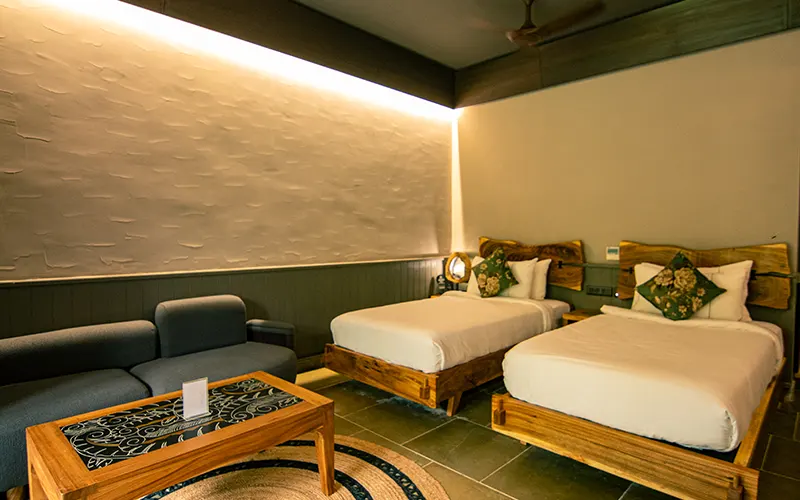
Joypur Forest

 Restaurant
Restaurant  Lawn (Restaurant Facing)
Lawn (Restaurant Facing)  Lawn (Banquet Facing)
Lawn (Banquet Facing)  Temple mini Prangan (lawn)
Temple mini Prangan (lawn)  Games block
Games block  Bar
Bar  Bar Deck & Waterbody
Bar Deck & Waterbody  Swimming Pool
Swimming Pool  Tent
Tent  Tower Rooms
Tower Rooms  Reception
Reception  Reception back Waterbody
Reception back Waterbody  Outdoor Play
Outdoor Play  Rope Walk
Rope Walk  Tree Macha
Tree Macha  Parking
Parking  Gym & Games Room
Gym & Games Room  Main Gate
Main Gate  Banquet
Banquet  Café
Café 







Chhau dance is one of the most famous dance forms of this region. Male dancers from local communities put different masks on them and dance at night in open places known as ‘akhada’. Folk songs, drums, dhol, shehnai, dhamsa and kharka are the musical instruments which are being played during a Chhau. Scenes from the Ramayana, Mahabharata, and other local sagas are represented by this dance form.
Bishnupur Mela is held from 23rd December to 27th December every year near the temple of Lord Madanmohon in Bishnupur. This mela is very famous and follows the tradition of Bishnupur immensely. There are stalls of wonderful terracotta artifacts, handcrafted items, different types of artworks and traditional Bishnupuri clothes in the Mela-ground. Bishnupur mela is the place where you will find the true essence of the rich musical culture of Bishnupur. Artists performing in cultural programs will surely please you from within. The temple town has its own musical origin popularly known as ‘Bishnupur Gharana of Singing’.
Bishnupur is a town famous for its terracotta temples and Baluchari sarees. The town has a glorious past that is reflected in its rich architecture, music, and handicrafts. It prospered in the 17th and early 18th centuries under the rule of a line of Hindu Rajas of the Malla dynasty. Bishnupur developed a unique form of architecture and has perhaps the most brilliant and detailed terracotta work in Eastern India that has withstood the ravages of time. The Terracotta tiles depict stories from Ramayana and Mahabharata. Temples like the Shyam Ray Temple, the twin shrines of Jorbangla and the Rasmancha are a must visit. It is also known for its traditional handloom sarees, pottery, artifacts, and jewellery made of terracotta, and the School of Hindustani Music which flourished under royal patronage along with the Bishnupur School of Painting. This style of music is still being kept alive in local academies of music. You can also visit the cannon named as Dal Madol was built by the Malla kings to fight the Maratha invasion. This Cannon is near Chinomasta temple and is significant for the people of Bishnupur as well as Bengal.
Panchmura village near Bishnupur temple town is the home of around 270 artists making Terracota items. The place is famous for long necked Terracota horses. Terracota means baked clay. The craftspeople color their products with clay itself and fire them in kilns with the help of dry Eucalyptus leaves.
Bikna is a village in Bankura district and the hub of Dokra artists in Bengal as well as in India. The tribal people of Bankura known as ‘Dokra Damar’ practiced this special form of art, ‘Dokra Metal Casting’. The core material of this crafting technique is clay over which wax coating is applied. After the wax coating, the models are applied with clay paste coating. Several objects have been prepared from this technique like religious symbols, jewelry, cutlery, bells. Many women prefer to wear dokra jewelry and this art has become a surviving legacy of Bishnupur.
Gangani is widely known as “Grand Canyon of Bengal” is a famous tourist & picnic spot situated by the town of Garhbeta of Paschim Medinipur district.. It comprises natural hills around the River Shilabati, locally known as “Shilai River”. The rains and seasonal variations, over time, have resulted in the formation of spectacular geological structures. These beautiful canyons like formations overlooking the river attract people from all corners of the state. During the winters, it attracts diverse migratory bird species. The place is situated on the banks of river Shilabati Gangani and is locally popular as “Gangani Danga” or “Gangani Khola”.
Kamarpukur and Jayrambati are two villages situated enroute to Joypur forest. Thousands of people visit these villages every year from various parts of the world and get spiritually refreshed and elevated.
Kamarpukur is best known as the birthplace of Sri Ramakrishna Paramahansa. The village was once surrounded by extensive fields, often looking like an island floating in a vast sea of green. Apart from agriculture, it was also noted for cottage industries. The signs of ancient prosperity are still visible everywhere at Kamarpukur. A number of ponds, tanks and old buildings and dilapidated temples still bear witness to its old glory.
Jayrambati is known as the birthplace of Sarada Devi, wife of Sri Ramakrishna. Unlike its twin Kamarpukur, the village began to show signs of prosperity mainly after Sarada Devi’s advent.
Mukutmanipur, situated at the confluence of rivers Kansabati and Kumari, is a home to tribes like Santhal, Bhumij (Sardar) and Munda, which indulge in a variety of dance forms, crafts, music and delectable food. Additionally, Mukutmanipur comprises the Kangsabati Dam – the second biggest earth dam of India and the Kangsabati Water Reservoir, forests and hillocks. It is a vibrant tourist destination, exhibiting culturally rich tribal traditions and festivals on one hand, and offering a serene, offbeat, and tranquil nature destination on the other.